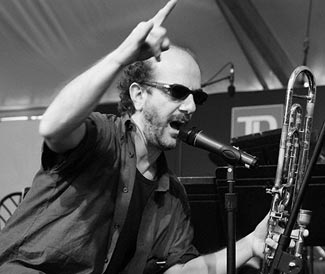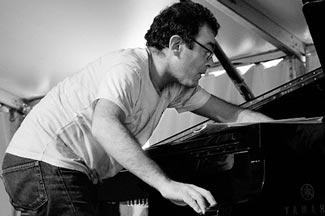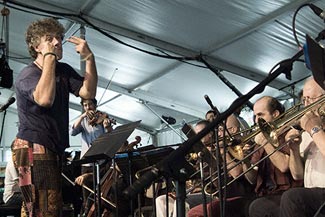 |
|
Italian Instabile Orchestra
|
| July 3, 2005 • Star Stage • Toronto |
|
|
| Report by Joyce Corbett with photos by Roger Humbert |
| Original and refreshing, the zesty music of the Italian Instabile Orchestra brings us into the 21st century via New Orleans and Mingus, Gil Evans and Beethoven with changing rhythms and tempos and complex polyphony. Each member of the orchestra is an exceptional musician and many are also composers and arrangers, yet they are completely unpretentious. They are serious musicians with a great sense of fun. They make the most of the full orchestra format and move freely between smaller configurations such as French horn and trombone, a trio of trumpets, a chamber group with cello and violin or drums and timpani. |

Sebastiano Tramontana |
|
The music they play reflects the structure of the orchestra itself (and vice versa). This band has no leader. Each piece is conducted by whichever member of the band composed or arranged it. The individual’s personalities (eighteen of them — individuals that is — possibly more personalities) are not submerged in the band. There is a basic unity, as there is a basic structure to the music but within that there is lots of room for individual expression and for improvisation. They go off on tangents, they create all manner of unusual sounds with their instruments — hiccupping, whinnying, fluttering and screeching; and sometimes with their voices — whoaaa, aaah, eh! And yet, this is highly accessible music. |
|
| The first piece of the show is the most classically constructed, “Hymns from the land of the Visiacs”. It was written by Giovanni Maier, the bass player, (that’s right, he’s conducting — so no bass player, just a cellist). It starts off with a pretty piano intro, then the drums march in. The piece grows into grandiosity with timpani boom-booming, then quickly changes as the trombone starts in on a solo. Electric cello comes in — sometimes bowed — sometimes plucked — and drums. The music of these instruments becomes progressively more disjointed as the other instruments come in forming a layered harmony of melodic sound. There is a piano solo that turns into a rhythmic pattern as horn shots take the place of rim shots. Then a whack on the drum announces the return of the full orchestra who cut out again, just as abruptly, as the trumpet starts a solo. The trumpet continues in the lead over heavy drumming as the band comes back in. The piece continues with bits of melody eventually returning, weaving in and out, the marching drums return and the lyricism.
The second piece, by saxophonist Daniele Cavallanti, has that triplety, distinctly jazz feel. A trumpet solo brings in that driving but melancholy and rather lost Miles sound so favoured in French film noir of the 50s (I’m thinking Ascenseur pour l’échaffaud in particular). There are some lush piano moments and some beautiful arrangements for piano, bass, drums and horns. There is an increasingly insane trombone solo that ends in fluttering rubato, and an intense repetition of a two-note motif which returns sporadically until a melodic line takes us out.
|

Fabrizio Puglisi |
|
Though the orchestra plays mostly their own new material two standards do make an appearance. Duke Ellington’s “Come Sunday”, as arranged (and of course conducted) by Giancarlo Schiaffini is no staid rehashing of an old tune but a springboard for creativity. It starts with a beautiful French horn and trombone duet as the drums quietly start to pulse. When the full band joins in, it is loose, rich and full of attitude. The piano does a bluesy solo, moving into Monk territory shortly before pianist Fabrizio Puglisi rises from his seat and reaches into the piano producing first a metallic piano sound, then some soft harp sounds, a knocking rhythm and clear bell-like tones. |
|
| Finally, to the accompaniment of some tight bass strings plucked by the hand in the piano, he creates a nice atmospheric motif on the keys as the band comes back in. A melodic alto section follows, horns play rhythm with the drum and when the soprano sax comes in, everything melds into a weird and wonderful dischord and the music de-composes as muted trumpet and trombone wah wah their way in. The other standard, J.J. Johnson’s “Lament”, comes up in the second set. It is also arranged by Giancarlo and is equally fresh and enjoyable.
One composition by Giancarlo integrates an incredible amount of what one would normally think of as disparate elements into a whole, with edges and tensions and surprises, of course. There are elements of the folkloric music of his native Sardinia, a pinch of Satie, marching sections — parade or funeral procession take your pick — a three note pattern repeated over several bars reminiscent of Beethoven, a groove laid down by timpani, drums and cymbals, and a reedy very “outside” baritone, all finished off with a timpani roll of thunder.
The Carlo Actis Dato piece starts out with a soul-gripping cello playing alone. Carlo, ever the comedian, pulls out a handkerchief and wipes his eyes and the cello picks up with a jazzy bass pattern. The rest of the orchestra comes in and completes the transformation into strongly syncopated jazz played at breakneck speed. The anticipated beat gives the feeling that they may start tripping over themselves at any moment. In the same piece I hear a bullfight coming on but then a middle eastern accented flute takes the fore. By the end, we are back to a cello solo. “I once had a girl, or should I say, she once had me”. It’s Norwegian Wood. The rest of the band comes in with exaggerated oohs and aahs, Tiziano Tononi hits the gong and it’s over.
|
| Eugenio Colombo starts off the second set conducting his “Warding off the Evil Spirits”. It starts with a series of odd vocalizations and shaker. A kind of craziness crescendos as the rest of the band joins in and mutates into a kind of gypsy jazz as we are led off into another musical creation. The piece ends abruptly as Eugenio jumps a considerable height off the stage. This is followed by Paolo Damiani conducting yet another interesting piece dedicated to the great Italian saxophonist Massimo Urbani. The performance, an immensely rich and satisfying musical experience, culminates with a barefoot Tiziano Tononi leaving his drums behind to conduct the band in a joyous South African piece. |
|

Tiziano Tononi (conducting) |
|
|
|
|
|
|
|




